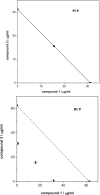Fractionation of hexane extracts from Achyrocline satureioides and their biological activities against Paenibacillus larvae
- PMID: 35349126
- PMCID: PMC9433582
- DOI: 10.1007/s42770-022-00736-y
Fractionation of hexane extracts from Achyrocline satureioides and their biological activities against Paenibacillus larvae
Abstract
Previous studies carried out in our laboratory described the antimicrobial activity of the whole hexanic extract (HE) of Achyrocline satureioides (Lam.) DC against Paenibacillus larvae, the causal agent of American Foulbrood (AFB) a disease of the honey bee larvae. In this study, the HE was partitioned into five main fractions by chromatographic techniques leading to the isolation of four known compounds: two prenylated phloroglucinol α-pyrones (1 and 3), 5,7-dihydroxy-3,8-dimethoxyflavone (gnaphaliin A) (2), and 23-methyl-6-O-demethylauricepyrone (4). Isolated compounds were further analyzed towards structural elucidation using 1H RMN and 13C RMN spectroscopic techniques. For the first time, the antimicrobial activity of the isolated compounds was evaluated against P. larvae strains by broth microdilution method and compared with that of the whole HE. Compounds 1-4 displayed minimum inhibitory concentration (MIC) and minimum bactericidal concentration (MBC) values ranging between 0.07 and 62.5 μg/mL and 0.26 and 12.5 μg/mL, respectively. The lowest MIC and MBC values were obtained with compounds 3 and 4, respectively. The antimicrobial activity of each single compound and the combination of them showed that the presence of all compounds is needed for the antimicrobial efficacy of whole HE.
Keywords: Achyrocline satureioides; American foulbrood; Bees; Honey; Paenibacillus larvae.
© 2022. The Author(s) under exclusive licence to Sociedade Brasileira de Microbiologia.
Conflict of interest statement
The authors declare no competing interests.
Figures
References
-
- Lindström A, Fries I. Sampling of adult bees for detection of American foulbrood (Paenibacillus larvae subsp. larvae) spores in honey bee (Apis mellifera) colonies. J Apic Res. 2015;44(2):82–86. doi: 10.1080/00218839.2005.11101154. - DOI
-
- Se recuerda que no está permitido el uso de antibióticos en las colmenas. Available from: www.senasa.gob.ar. Accessed July 3, 2021.
MeSH terms
Substances
LinkOut - more resources
Full Text Sources



